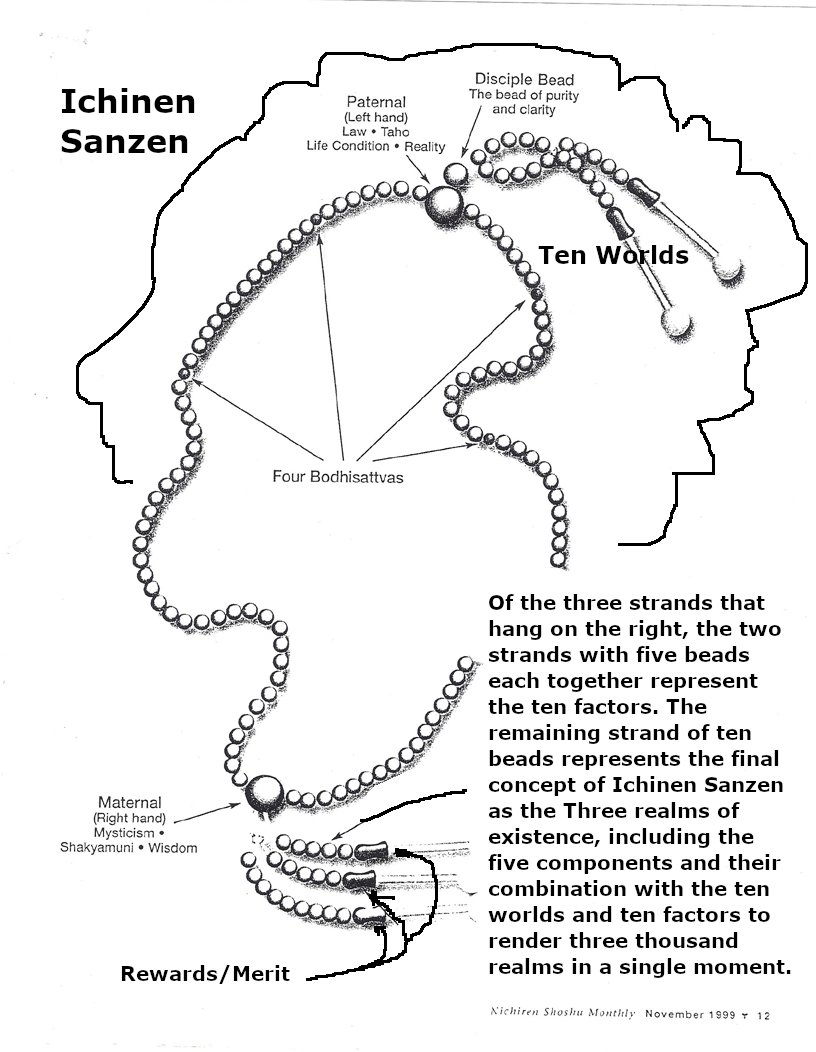| |
The Meditation Beads
The Mokugenji Sutra states:
A King named Haruri once spoke these words in sorrow to the Buddha: “In recent years famine and pestilence have plagued my small country. All the people are distressed. I am always worrying about this. We are in a painful position.
The storehouse of the Law is too profound and extensive to practice. Please teach me the main point of the Law.
The Buddha replied: “King, if you want to eliminate earthly desires, make a circular string of 108 wooden beads. Hold them always to yourself. Recite ‘Namu Buddha-Namu Dharma-Namu Sangha’; Count one bead with each recitation.”
This is the origin of the meditation beads. As this sutra indicates, the Buddha advised the king to hold a string of beads. We follow this tradition when meditating on the Three Treasures, or when counting recitations of the Daimoku.
Nichikan Shonin further stated:
A circle of beads manifests the character Myo. Miao-lo stated in his writing ‘The Annotations on the Great Concentration and Insight’: “There is no Lack in the principle Myo.” Therefore we use a circle of beads that compares to
the unending potential of the principle, Myo. The basic number of beads is 108, which is said to represent the number of earthly desires possessed by common mortals.
In Quantum Life Buddhism, as in the Buddhas words, “Namu-Buddha” is dedication and conviction to the complete and ultimate teachings of Buddha as manifest in the Buddha-nature, “Namu-Dharma” is dedication and conviction to the
complete and ultimate teachings of Buddha as manifest in the Daimoku and our practice, and “Namu-Sangha” is dedication and conviction to the complete and ultimate teachings of Buddha as manifest in our shared practice with others
whenever possible. These are the Three Treasures, Buddhahood itself, the teachings to lead directly to Buddhahood, and the sharing, study, and practice of those teachings.
Our meditation beads consist of two long strands joined at either end with two large beads. Hanging from the outside of these large beads are two shorter strands on one end, and three on the other.
They are strung with white braided cords with white pompom tassels at the end. These sets of two and three strands are equidistant and opposite from each other. The two large beads are called the father and the mother beads.
Both of them together represent the Buddha.
When we use the beads, we twist the circle once, forming a figure eight, or infinity symbol. The end of the symbol with three strands is placed over the middle finger of the right hand, and the end with the two strands is placed
over the middle finger of the left hand. The short strands are left to dangle on the outside of the hands as the hands are brought together with palms facing and the fingers folded right hand over left for men and left hand over
right for women. Take care to fold the fingers over the thumbs and not underneath. This presses the two palm shakras together and forms a ball or sphere at the chest. This is a position of ownership, receptiveness, and
anticipation.
Between the father and mother beads are 108 of smaller size. These represent earthly desires. You will find also, four smaller beads. They are opposite each other, two being seven beads away from the end with two strands, and the
other two are fourteen beads beyond the first two. These four small beads represent the four leaders of the Bodhisattvas of the Earth – Jogyo, Muhengyo, Jyogyo, and Anryugyo – And also indicate the four virtues of the
Buddha’s Life. These are Eternity, Happiness, True Self, and Purity.
Directly under the father bead, which is at the end with two tassels, is a smaller bead. This represents the essential nature of the Law, the Essential creative core, the eternal, absolute Truth.
The strands that hang from the outside of the middle fingers represent the concept of Ichinen Sanzen or 3000 Realms in each thought moment of life. The two strands of ten beads each that hang from the left signify the ten worlds
and their mutual possession. Of the three strands that hang on the right, the two strands with five beads each together represent the ten factors. The remaining strand of ten beads represents the final concept of Ichinen Sanzen
as the Three realms of existence (the realm of the five components, the realm of living beings, and the realm of the environment), with the five components (An analysis of the nature of a living entity in terms of how it responds
to its surroundings. The five components are: form, perception, conception, volition, and consciousness.), and their combination with the mutually possessed ten worlds (1-Hell, 2-Hunger or hungry spirits, 3-Animality, 4-Asuras or
angry demons, 5-Humanity or human beings, 6-Rapture or heavenly being, 7-Voice hearers or Learning and literally meaning those who hear the Buddha’s teaching, 8-Cause awakened ones or literally those who understand the Buddha’s
teachings and dedicate their lives to awakening, 9-Bodhisattvas or those who take on the Buddha’s mission for others, and 10-Buddhas), and ten factors or ten suchnesses (1-Appearance: attributes of things discernible from the
exterior such as form, color, shape, and behavior. 2-Nature: the inherent disposition or quality of a thing or being that cannot be discerned from the outside. 3-Entity: the essence of life that permeates and integrates
appearance and nature. 4-Power: life’s potential energy, 5-Inlfuence: the action or movement produced when life’s inherent power is activated. 6-Internal Cause: the cause latent in life that produces an effect of the same
quality as itself i.e. good, evil or neutral. 7-Relation: the relationship of indirect causes to the internal cause. Indirect causes are various conditions, both internal and external, that help the internal cause produce an
effect. 8-Latent Effect: the effect produced in life when an internal cause is activated through its relationship with various conditions. 9-Manifest Effect: the tangible perceivable result that emerges in time as an expression
of a latent effect and therefore an internal cause, again through its relationship with various conditions. 10-Consistency from beginning to end: the unifying factor of the ten factors. It indicates that all of the other nine
factors from the beginning, Appearance to the end, Manifest Effect, are consistently and harmoniously interrelated. All nine factors thus consistently and harmoniously express the same condition of existence at any
given moment.); rendering the equation, 3 realms X 10 Factors = 30 X 10 Worlds = 300 X Ten Worlds mutually possessed = 3000 or, three thousand realms in a single moment.
The Buddha’s basic teaching on life is that our manifestation as humans is a string of these Ichinen Sanzen moments occurring one after the next. Our advent in this life is to ensure that there is no remainder from one moment to
the next. More on this will be clarified by study.
Because of their profound significance, you should treat your meditation beads with respect, just as you would Buddha. To understand the meaning of the beads is to begin to understand the profundity of Buddhism, the correct
practice, and the reason for expressing gratitude to the Three Great Secret Laws – The objective of devotion of the essential teaching (Gohonzon, both as represented through Mandala or mirror and the essential truth of this
Buddha nature within the mind inseparable from your life), the Daimoku of the essential teaching (NaMuMyoHoRenGeKyo, invoking that innate Buddha nature to awaken it), and the sanctuary of the essential teaching (meaning both
the Butsudan housing the Gohonzon, and the essential core of your life), and the Three Treasures as discussed earlier.

|














